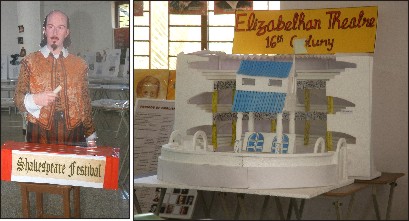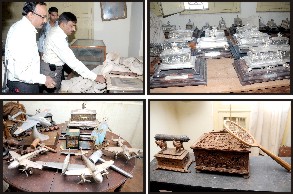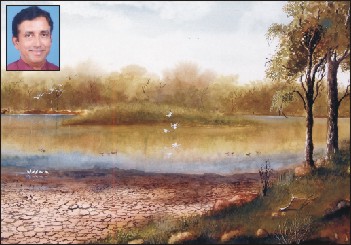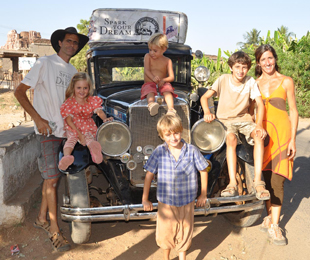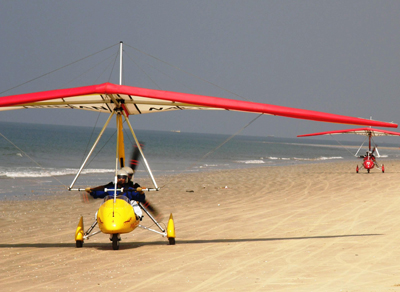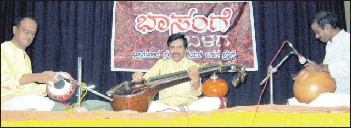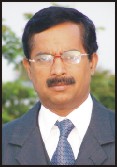
Mysore:
The tale of Yaduvamsha begins with Yaduraya marrying Devajammanni (1399), the daughter of Chamaraja who had died without a direct male heir. Yaduraya inherited the small principality of Mysuru which consisted of 33 villages earning a sum of 3,000 varahas annually.
First Palace: It is a matter of conje-cture as how the Palace of Yaduraya looked like. It must have been an enormous one with many courtyards than a regular house. This first Palace of Wadiyars was struck down by lightning sometime in mid 17th century.
Second Palace: A second Palace was built within a secure fortress during the reign of dynamic king. Ranadheera Kanteerava Narasaraja Wadiyar (1638-59). As per written records, this Palace contained various halls, pavilions, quadrangles and temples. The fort was filled with residences of artists, singers, dancers, musicians, scholars and jesters and an army of soldiers. With the ascension of Tipu, he declared himself Sultan and slowly worked to obliterate the heritage of Wadiyars. He dismantled the Palace and the fort at Mysore, and went about to establish a new town ‘Nazarabad’ just across the Devaraya Sagara. His plans, however, came to nought midway and never materialised.
Tipu died in the IV Anglo Mysore War in 1799. The 4-year-old Krishnaraja Wadiyar III was to ascend the throne after moving the capital to Mysore. Palace records state that the coronation was performed within the premises of Lakshmiramana temple since the Palace was in ruins. Hastily, a new Palace was built (1799-1801) on the foundations of the old Palace which was richer and grander compared to its predecessor.
Third Palace: This Palace was built in 1801 to house the royal family after shifting the capital from Srirangapatna. This east facing edifice was built in typical tradition of the times, had four huge twin wooden columns standing two storeys high. The colonnaded ground floor sported a handsome plinth (jagali). The main entrance to the Palace was a painted pair of elephants flanking the main door. The colonnaded hall on the first floor was the durbar hall where the Maharajah was seated on the golden throne during Navaratri celebrations. The complex had 24 peristyles or colonnaded courtyards (totti) each serving a specific purpose catering to the different administrative wings of the Palace including a reception area, meeting hall, etc.
Three more floors rose above in a pyramidal fashion, the topmost bearing pancha kalasha. Prominently placed was a stucco image of Goddess Gaja Lakshmi. The Palace was a five storey wooden structure of teak, rosewood and sandalwood. Ornamental silver door frames, carved wooden pillars, niches, murals and paintings decorated the halls and corridors of this Palace. The Palace was 245 feet long, 156 feet wide and stood 145 feet tall. The fort (1350 feet x 1400 feet) was also rebuilt at the same time.
The coronation ceremony of Krishnaraja Wadiyar IV in 1895 and the wedding celebrations of Princess Jayalakshmammanni in 1897 were the last two major events hosted in this Palace under the regent Rajamata Vanivilasa Sannidhana before it was gutted in an accidental fire in February 1897.
Fourth Palace: The fourth Palace was rebuilt at the same place under the command of Rajamata Kempa-nanjammanni Vanivilasa, designed by British architect Henry Irwin, built by executive engineer B.P. Raghavulu Naidu at a cost of Rs. 41 lakhs. Amba Vilasa was one of the prominent royal Palaces to be built at the dawn of 20th century and it attracted critical acclaim at the global level during its construction and finishing stages.
Clearing of the Fort: An enormous number of public buildings, houses, mansions and bhajana mandiras were demolished between 1908-10.
In fact, an entire township within the old fort walls was cleared to create the ambience and look as seen today. The perfect unhindered view of the Amba Vilasa in any direction and angle within the ramparts is a mesmerising sight. The Palace construction was completed in 1912.
Construction of the Darbar Hall: In the year 1930, Krishnaraja Wadiyar IV sought for renovation of the front facade of the new Palace. Portico of the main entrance was demolished and a magnificent durbar hall with 9 arches supported by 10 pillars, was built at a cost of Rs. 6,21,000. The capitals of these arches sport the turbaned Mysore soldiers and the famed Mysore Lancers.
The northern and southern twin towers with three domes were the last addition to the new durbar hall in 1932. Proceedings of the Durbar Hall Committee meeting on 11 May 1934 states, “The committee examined 13 designs received for the durbar hall ceiling. The design submitted by K.S. Siddalingaswamy is considered the best among the designs received since the whole design is entirely original and fully oriental in conception and it strictly confirms to the canons of Shilpa Shastra.”
Inside the Palace: The interiors are no exception when it comes to the opulence and beauty. The private durbar hall is definitely the crown jewel of the Palace. The turquoise, gold and red painted pillars with hanging mango brackets and fairies in relief support a majestic stained glass ceiling in the centre.
It was the acclaimed artist K. Venkatappa whose three bas relief sculptures adorn the private durbar hall; he also provided the rich colour scheme to this hall along with several other wings of the new Palace. Rosewood doors inlaid with ivory, doors with silver repousse work, huge chandeliers, enhance the richness of the hall. The octagonal marriage pavilion has 26 paintings of Dasara procession and other celebrations painted by seven well known artists of the time.
An armoury room Ayudhashala within the Palace has about 725 catalogued arms and armoury belonging to different kings of Wadiyar dynasty and also a few arms wielded by Hyder Ali and Tipu Sultan. This armoury was established in 1635 by Chamaraja Wadiyar V. The contents of this room were documented for the first time during the reign of Krishnaraja Wadiyar III and all the arms were inscribed Sri Krishna. The weapons carried by the Ursu noblemen and those worshiped during Ayudha Puja are later deposited here.
Gateways of the Fort: Apart from the five magnificent imposing gates of the Palace, there are two minor gates and one gate on the west which is a relic from the reign of Krishnaraja Wadiyar III. This western gateway to the fort, Bra-hmapuri, opens out on to the road which directly leads to the Jaganmohan Palace — the royal residence between 1897 and 1907.
The south-western gateway is called Karikallu Thotti Dwara. The stucco work in spandrels and on the pillars is of very high craftsmanship. This gate offers a direct access to temples of Khille Venkataramana Swamy, Lakshmiramana Swamy and Prasanna Krishna Swamy which are often visited by citizens.
The eastern rampart of Mysore fort is punctuated by an inspiring, gigantic arched gateway Jaya Martanda Dwara with adjoining corridors. A grand pano-ramic view of the front facade of the Pa-lace which includes the bulbous domes and the gold plated central spire, the massive arches and the side flanks topped with the terracotta coloured domes comes alive as one approaches the Amba Vilasa.
Even after the construction of the main Palace in 1912, several structures were being altered. Archival records state that the ‘T’ shaped corridors adjoining the east fort gate were constructed in 1933.
The southern gate Varaha Dwara of Mysore fort is dedi-cated to the presiding deity of the Shweta Varahaswamy temple. A stucco image of Kaliya Mardana in an arched pediment on this gate has stood silent sentinel to the departed royalty en route to Madhuvana. The towering gopura of the Shweta Varahaswamy temple is decorated with stucco niches and figures. The main temple is a relic from the Hoysala times. Chikka Devaraja Wadiyar (1673-1704) brought the idol of Shweta Varahaswamy from Shrimushnam, Tamilnadu. It was installed in a temple at Srirangapatna which was destroyed in 18th century.
Krishnaraja Wadiyar III, under the supervision of Dewan Poornayya got the idol installed in the present temple. The Ambujavalli shrine dedicated to the consort is a low ceiling pillared structure. Both temples have their interiors painted with Mysore style murals depicting episodes from the Ramayana and Bhagavad Gita.
The twin gates in the northern side Jayarama and Balarama have a temple dedicated to Anjaneya in between them, both the gateways have arched pediment with the royal coat of arms of Wadiyars with the legend Satyamevoddharamyaham. The inner walls of central arch of both gates sport mural paintings of the Bangalore Palace, Jog Falls, Ooty Fernhill Palace and the old Palace by master portraitist Madhugiri Ramoo done in 1951.
Bronze tigers, created by British artist Robert William Colton, are placed two each flanking the north, south and east pathways in front of the Palace. Around 97,000 electric bulbs, when lit, dot the outline of the super structure and allied buildings within the fort presenting an awe inspiring sight.
Archival records state that the formal griha pravesha of the new Palace was performed in 1907; the first major event hosted in the Palace was the upanayana of Yuvaraja Kanthirava Narasaraja Wadiyar in 1910 while the marriage festivals were conducted at the grand hall of Jaganmohan Palace. The major event at the Palace during the reign of Nalwadi was the silver jubilee of his coronation in 1927 and the last spectacular event in the grand hall of Amba Vilasa was the coronation durbar of king Jayachamaraja Wadiyar on Aug. 8, 1940.
Mysore Palace – Celebrating a Century: City-based art foundation Ramsons Kala Pratishtana has published a unique journal Mysore Palace – Celebrating a Century using 82 photographs and paintings depicting various stages of the Palace being built. The journal is made up of two parts — the first part has photographs and texts depicting the making of Mysore Palace while the second part has ruled pages where one can write their experiences and thoughts when they visit the Palace.
The Journal will be released by Palace Board Deputy Director T.S. Subramanya at a function to be held tomorrow at 11 am at Pratima Gallery in front of City Zoo. Historian Prof. P.V. Nanjaraja Urs will be the chief guest. For details about the journal, contact Raghu on Mob. 9880111625.
— R.G. Singh, Secretary, Ramsons /Kala Pratishtana
source: http://www.StarofMysore.com / Feature Articles / March 03rd, 2012
